Analysis of Front Desk Management System at Yellow Pagoda Hotel
VerifiedAdded on 2021/08/23
|17
|2813
|485
Report
AI Summary
This report, submitted by Dipen Basnet and colleagues from the College of Applied Business, analyzes the front desk management system of Yellow Pagoda Hotel. The report details the hotel's use of IDS NEXT software, a cloud-based platform for front desk management, to improve guest experience and increase revenue. It explores the benefits of the software, including enhanced user experience, guest engagement, and operational efficiency. The report also includes an overview of the hotel's organizational structure, business processes, and SWOT analysis. Furthermore, it examines the various modules of IDS NEXT software used in front office management, such as chain-level guest profiles. The report concludes with recommendations for further improvement and references relevant figures and tables.
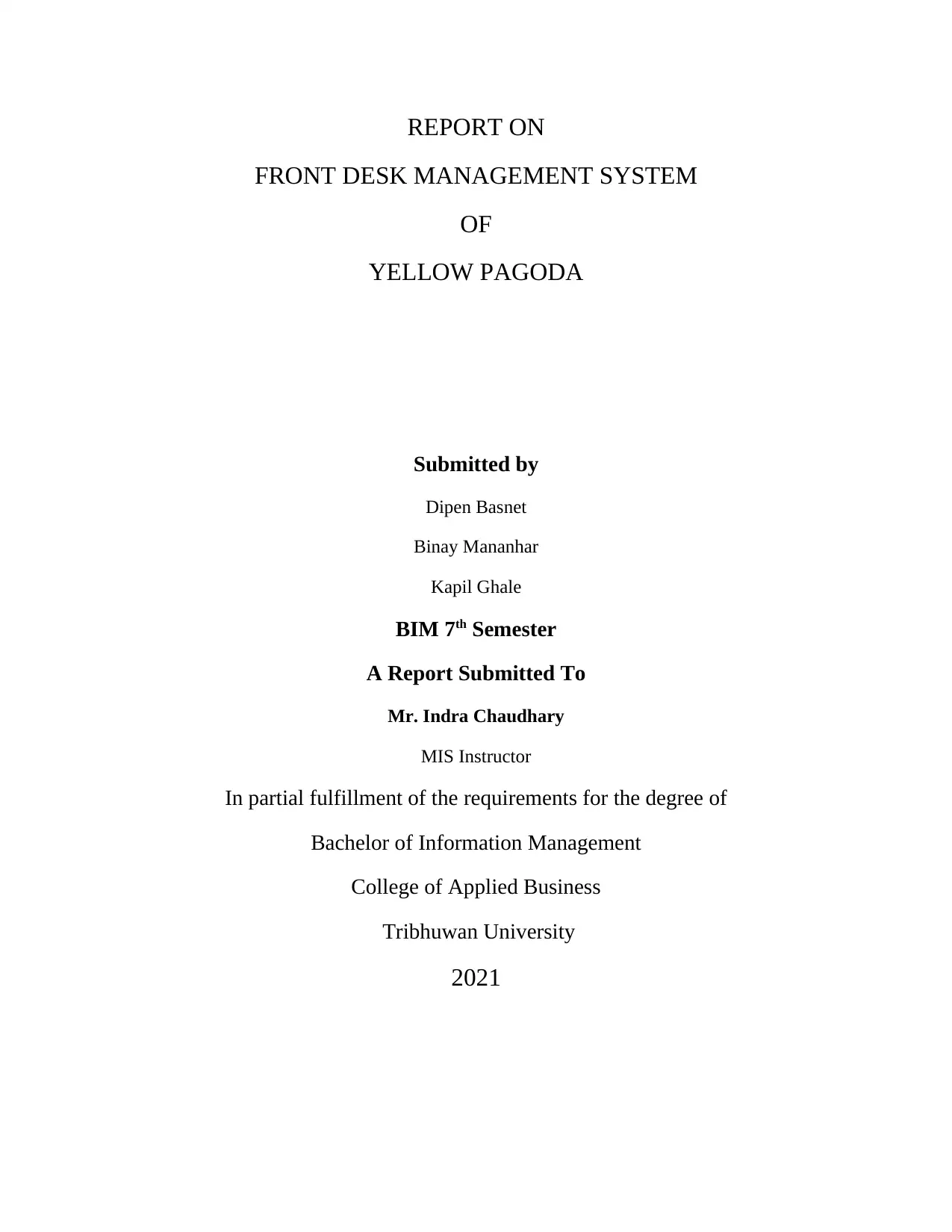
REPORT ON
FRONT DESK MANAGEMENT SYSTEM
OF
YELLOW PAGODA
Submitted by
Dipen Basnet
Binay Mananhar
Kapil Ghale
BIM 7th Semester
A Report Submitted To
Mr. Indra Chaudhary
MIS Instructor
In partial fulfillment of the requirements for the degree of
Bachelor of Information Management
College of Applied Business
Tribhuwan University
2021
FRONT DESK MANAGEMENT SYSTEM
OF
YELLOW PAGODA
Submitted by
Dipen Basnet
Binay Mananhar
Kapil Ghale
BIM 7th Semester
A Report Submitted To
Mr. Indra Chaudhary
MIS Instructor
In partial fulfillment of the requirements for the degree of
Bachelor of Information Management
College of Applied Business
Tribhuwan University
2021
Paraphrase This Document
Need a fresh take? Get an instant paraphrase of this document with our AI Paraphraser
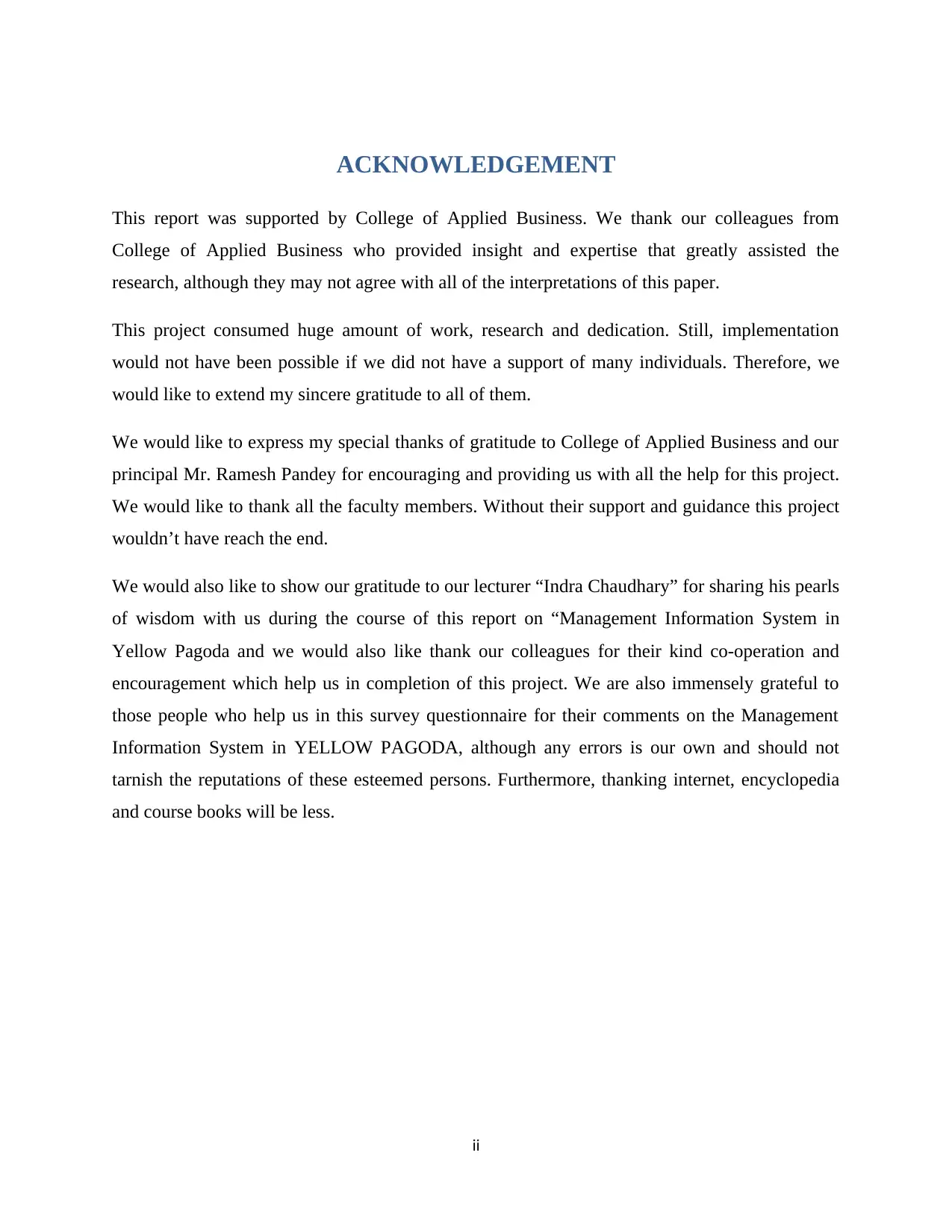
ACKNOWLEDGEMENT
This report was supported by College of Applied Business. We thank our colleagues from
College of Applied Business who provided insight and expertise that greatly assisted the
research, although they may not agree with all of the interpretations of this paper.
This project consumed huge amount of work, research and dedication. Still, implementation
would not have been possible if we did not have a support of many individuals. Therefore, we
would like to extend my sincere gratitude to all of them.
We would like to express my special thanks of gratitude to College of Applied Business and our
principal Mr. Ramesh Pandey for encouraging and providing us with all the help for this project.
We would like to thank all the faculty members. Without their support and guidance this project
wouldn’t have reach the end.
We would also like to show our gratitude to our lecturer “Indra Chaudhary” for sharing his pearls
of wisdom with us during the course of this report on “Management Information System in
Yellow Pagoda and we would also like thank our colleagues for their kind co-operation and
encouragement which help us in completion of this project. We are also immensely grateful to
those people who help us in this survey questionnaire for their comments on the Management
Information System in YELLOW PAGODA, although any errors is our own and should not
tarnish the reputations of these esteemed persons. Furthermore, thanking internet, encyclopedia
and course books will be less.
ii
This report was supported by College of Applied Business. We thank our colleagues from
College of Applied Business who provided insight and expertise that greatly assisted the
research, although they may not agree with all of the interpretations of this paper.
This project consumed huge amount of work, research and dedication. Still, implementation
would not have been possible if we did not have a support of many individuals. Therefore, we
would like to extend my sincere gratitude to all of them.
We would like to express my special thanks of gratitude to College of Applied Business and our
principal Mr. Ramesh Pandey for encouraging and providing us with all the help for this project.
We would like to thank all the faculty members. Without their support and guidance this project
wouldn’t have reach the end.
We would also like to show our gratitude to our lecturer “Indra Chaudhary” for sharing his pearls
of wisdom with us during the course of this report on “Management Information System in
Yellow Pagoda and we would also like thank our colleagues for their kind co-operation and
encouragement which help us in completion of this project. We are also immensely grateful to
those people who help us in this survey questionnaire for their comments on the Management
Information System in YELLOW PAGODA, although any errors is our own and should not
tarnish the reputations of these esteemed persons. Furthermore, thanking internet, encyclopedia
and course books will be less.
ii
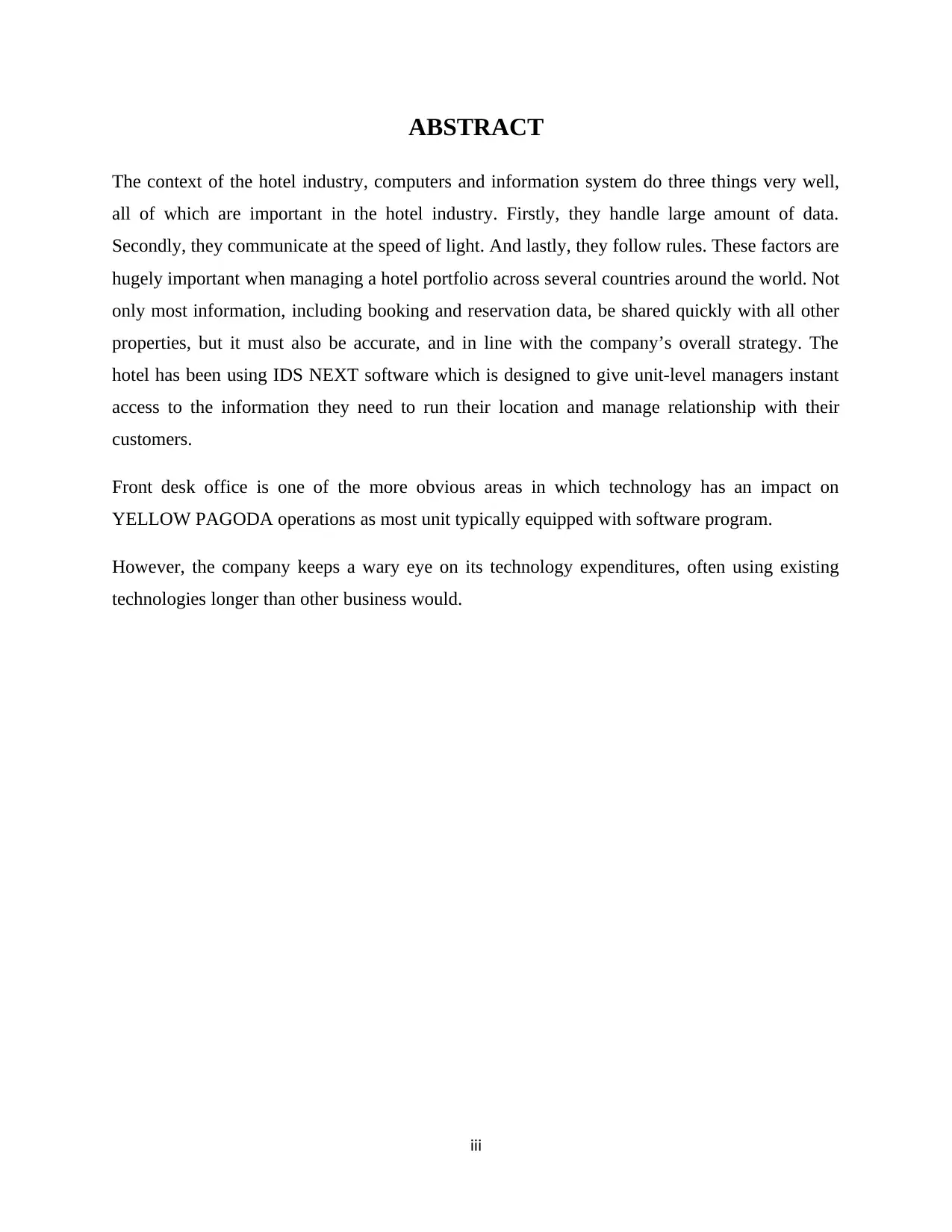
ABSTRACT
The context of the hotel industry, computers and information system do three things very well,
all of which are important in the hotel industry. Firstly, they handle large amount of data.
Secondly, they communicate at the speed of light. And lastly, they follow rules. These factors are
hugely important when managing a hotel portfolio across several countries around the world. Not
only most information, including booking and reservation data, be shared quickly with all other
properties, but it must also be accurate, and in line with the company’s overall strategy. The
hotel has been using IDS NEXT software which is designed to give unit-level managers instant
access to the information they need to run their location and manage relationship with their
customers.
Front desk office is one of the more obvious areas in which technology has an impact on
YELLOW PAGODA operations as most unit typically equipped with software program.
However, the company keeps a wary eye on its technology expenditures, often using existing
technologies longer than other business would.
iii
The context of the hotel industry, computers and information system do three things very well,
all of which are important in the hotel industry. Firstly, they handle large amount of data.
Secondly, they communicate at the speed of light. And lastly, they follow rules. These factors are
hugely important when managing a hotel portfolio across several countries around the world. Not
only most information, including booking and reservation data, be shared quickly with all other
properties, but it must also be accurate, and in line with the company’s overall strategy. The
hotel has been using IDS NEXT software which is designed to give unit-level managers instant
access to the information they need to run their location and manage relationship with their
customers.
Front desk office is one of the more obvious areas in which technology has an impact on
YELLOW PAGODA operations as most unit typically equipped with software program.
However, the company keeps a wary eye on its technology expenditures, often using existing
technologies longer than other business would.
iii
⊘ This is a preview!⊘
Do you want full access?
Subscribe today to unlock all pages.

Trusted by 1+ million students worldwide
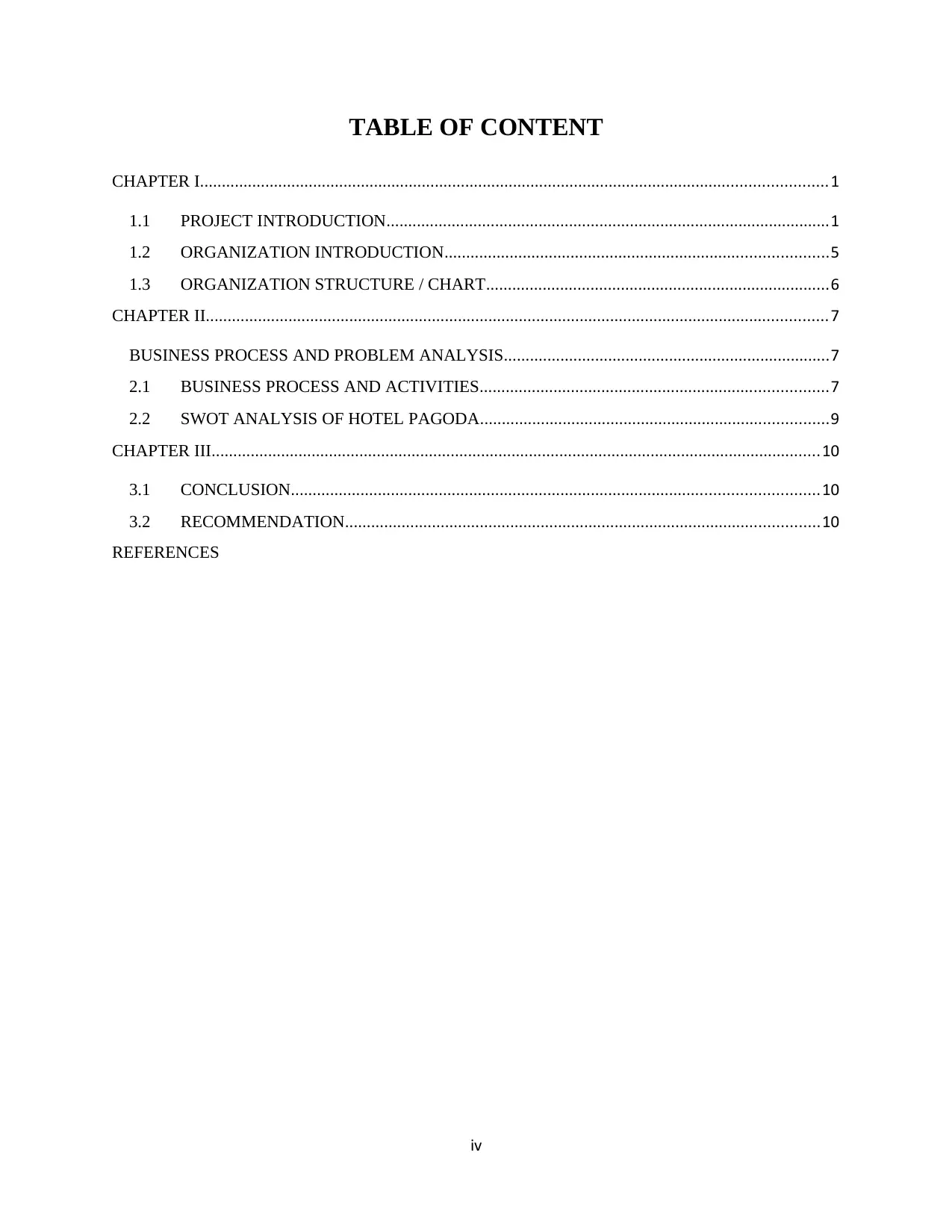
TABLE OF CONTENT
CHAPTER I................................................................................................................................................1
1.1 PROJECT INTRODUCTION......................................................................................................1
1.2 ORGANIZATION INTRODUCTION........................................................................................5
1.3 ORGANIZATION STRUCTURE / CHART...............................................................................6
CHAPTER II...............................................................................................................................................7
BUSINESS PROCESS AND PROBLEM ANALYSIS...........................................................................7
2.1 BUSINESS PROCESS AND ACTIVITIES................................................................................7
2.2 SWOT ANALYSIS OF HOTEL PAGODA................................................................................9
CHAPTER III............................................................................................................................................10
3.1 CONCLUSION.........................................................................................................................10
3.2 RECOMMENDATION.............................................................................................................10
REFERENCES
iv
CHAPTER I................................................................................................................................................1
1.1 PROJECT INTRODUCTION......................................................................................................1
1.2 ORGANIZATION INTRODUCTION........................................................................................5
1.3 ORGANIZATION STRUCTURE / CHART...............................................................................6
CHAPTER II...............................................................................................................................................7
BUSINESS PROCESS AND PROBLEM ANALYSIS...........................................................................7
2.1 BUSINESS PROCESS AND ACTIVITIES................................................................................7
2.2 SWOT ANALYSIS OF HOTEL PAGODA................................................................................9
CHAPTER III............................................................................................................................................10
3.1 CONCLUSION.........................................................................................................................10
3.2 RECOMMENDATION.............................................................................................................10
REFERENCES
iv
Paraphrase This Document
Need a fresh take? Get an instant paraphrase of this document with our AI Paraphraser
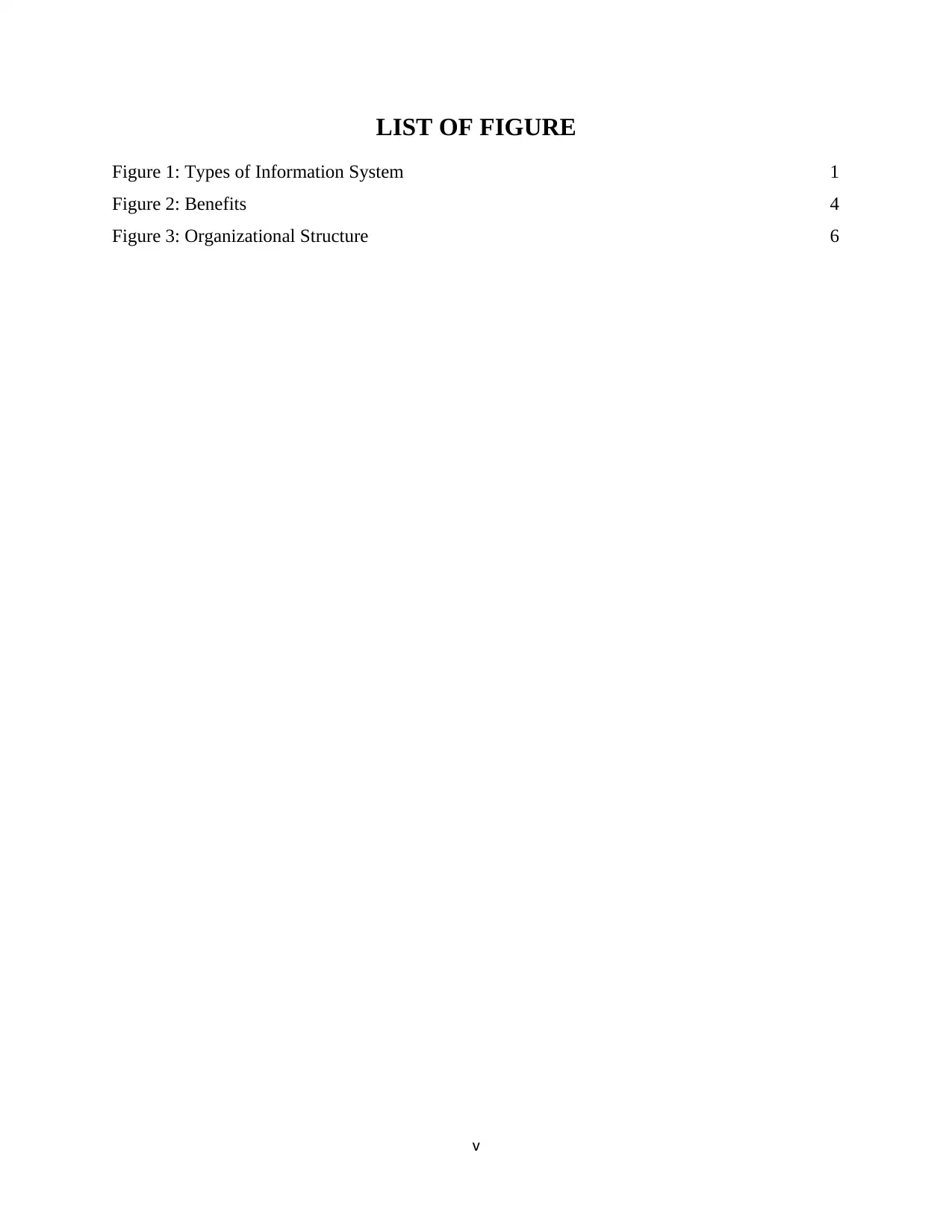
LIST OF FIGURE
Figure 1: Types of Information System 1
Figure 2: Benefits 4
Figure 3: Organizational Structure 6
v
Figure 1: Types of Information System 1
Figure 2: Benefits 4
Figure 3: Organizational Structure 6
v
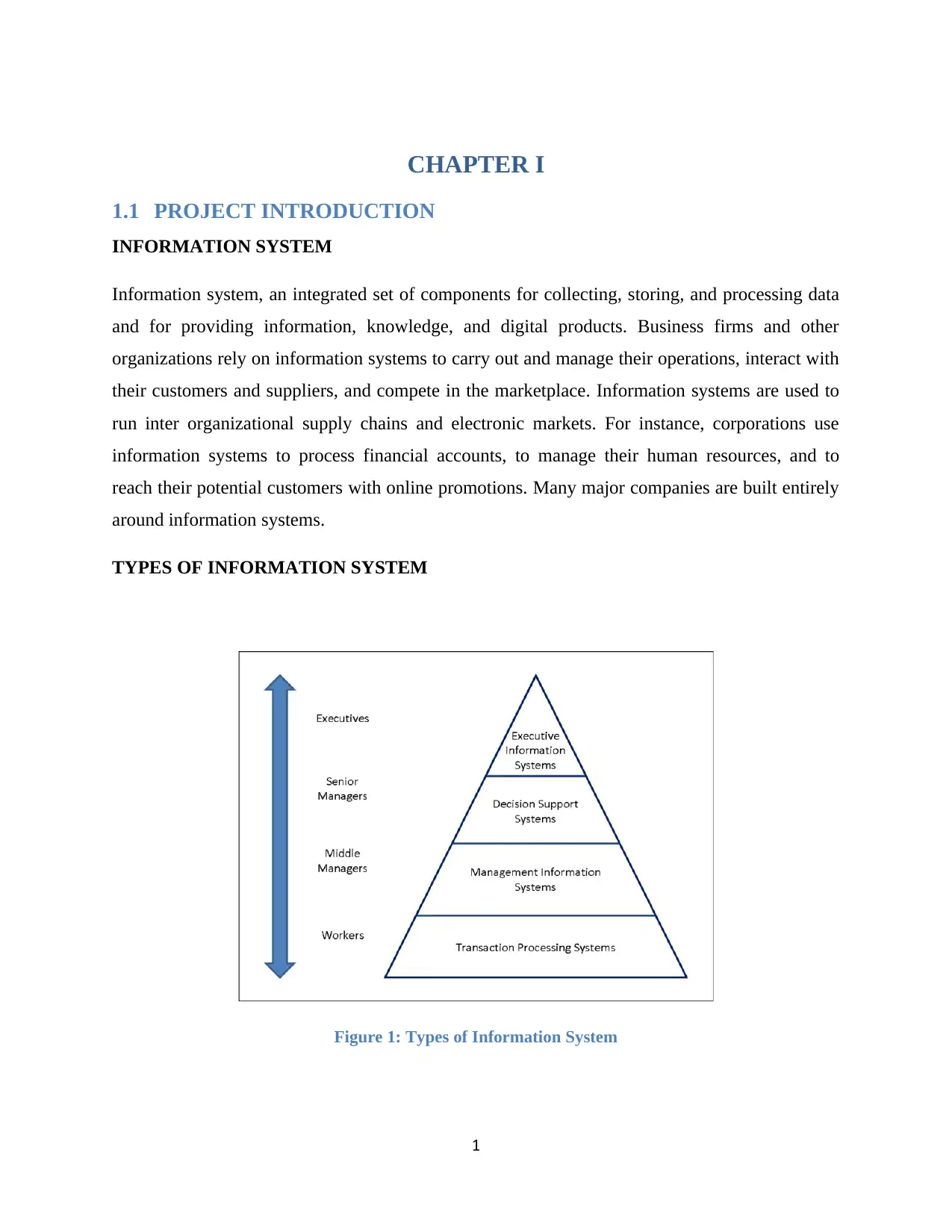
CHAPTER I
1.1 PROJECT INTRODUCTION
INFORMATION SYSTEM
Information system, an integrated set of components for collecting, storing, and processing data
and for providing information, knowledge, and digital products. Business firms and other
organizations rely on information systems to carry out and manage their operations, interact with
their customers and suppliers, and compete in the marketplace. Information systems are used to
run inter organizational supply chains and electronic markets. For instance, corporations use
information systems to process financial accounts, to manage their human resources, and to
reach their potential customers with online promotions. Many major companies are built entirely
around information systems.
TYPES OF INFORMATION SYSTEM
Figure 1: Types of Information System
1
1.1 PROJECT INTRODUCTION
INFORMATION SYSTEM
Information system, an integrated set of components for collecting, storing, and processing data
and for providing information, knowledge, and digital products. Business firms and other
organizations rely on information systems to carry out and manage their operations, interact with
their customers and suppliers, and compete in the marketplace. Information systems are used to
run inter organizational supply chains and electronic markets. For instance, corporations use
information systems to process financial accounts, to manage their human resources, and to
reach their potential customers with online promotions. Many major companies are built entirely
around information systems.
TYPES OF INFORMATION SYSTEM
Figure 1: Types of Information System
1
⊘ This is a preview!⊘
Do you want full access?
Subscribe today to unlock all pages.

Trusted by 1+ million students worldwide
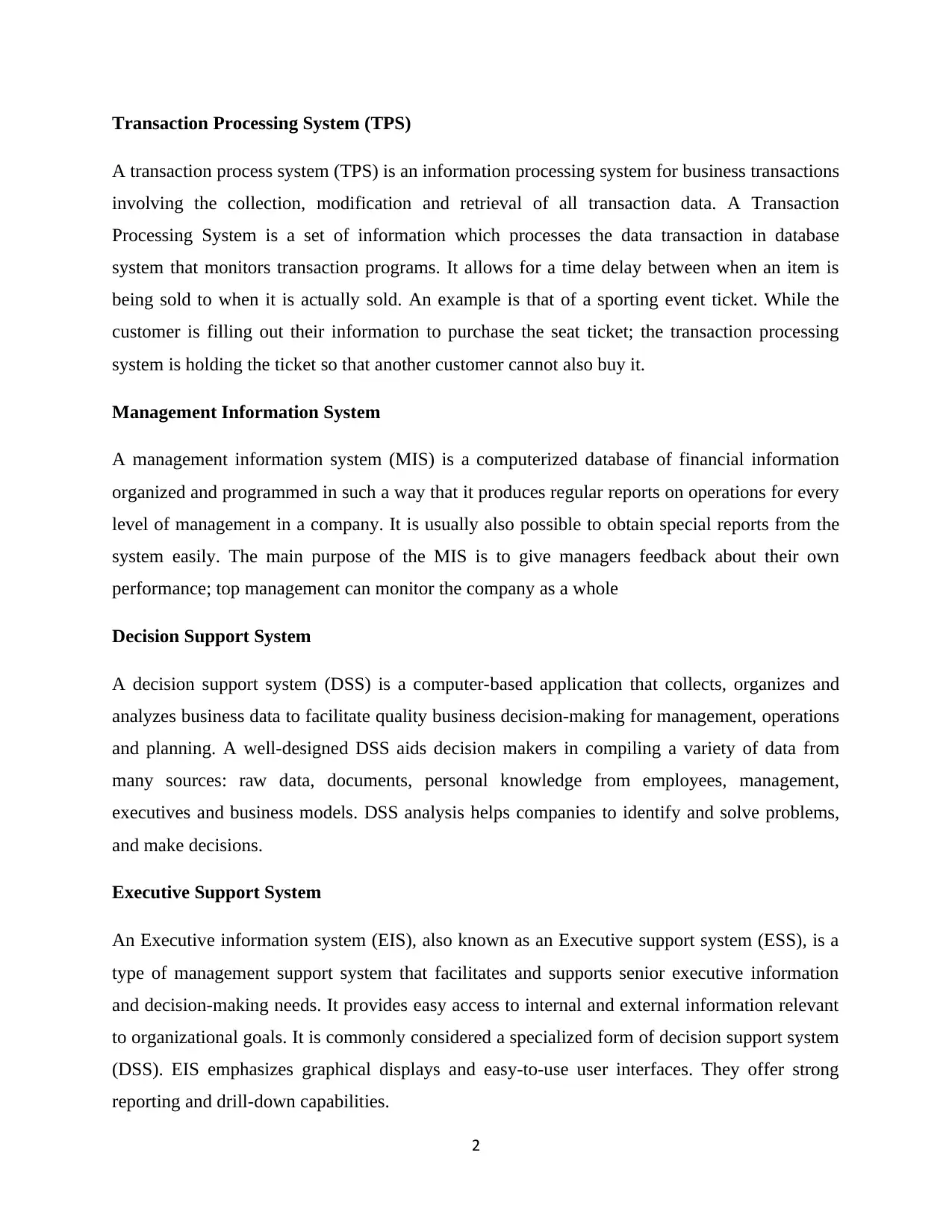
Transaction Processing System (TPS)
A transaction process system (TPS) is an information processing system for business transactions
involving the collection, modification and retrieval of all transaction data. A Transaction
Processing System is a set of information which processes the data transaction in database
system that monitors transaction programs. It allows for a time delay between when an item is
being sold to when it is actually sold. An example is that of a sporting event ticket. While the
customer is filling out their information to purchase the seat ticket; the transaction processing
system is holding the ticket so that another customer cannot also buy it.
Management Information System
A management information system (MIS) is a computerized database of financial information
organized and programmed in such a way that it produces regular reports on operations for every
level of management in a company. It is usually also possible to obtain special reports from the
system easily. The main purpose of the MIS is to give managers feedback about their own
performance; top management can monitor the company as a whole
Decision Support System
A decision support system (DSS) is a computer-based application that collects, organizes and
analyzes business data to facilitate quality business decision-making for management, operations
and planning. A well-designed DSS aids decision makers in compiling a variety of data from
many sources: raw data, documents, personal knowledge from employees, management,
executives and business models. DSS analysis helps companies to identify and solve problems,
and make decisions.
Executive Support System
An Executive information system (EIS), also known as an Executive support system (ESS), is a
type of management support system that facilitates and supports senior executive information
and decision-making needs. It provides easy access to internal and external information relevant
to organizational goals. It is commonly considered a specialized form of decision support system
(DSS). EIS emphasizes graphical displays and easy-to-use user interfaces. They offer strong
reporting and drill-down capabilities.
2
A transaction process system (TPS) is an information processing system for business transactions
involving the collection, modification and retrieval of all transaction data. A Transaction
Processing System is a set of information which processes the data transaction in database
system that monitors transaction programs. It allows for a time delay between when an item is
being sold to when it is actually sold. An example is that of a sporting event ticket. While the
customer is filling out their information to purchase the seat ticket; the transaction processing
system is holding the ticket so that another customer cannot also buy it.
Management Information System
A management information system (MIS) is a computerized database of financial information
organized and programmed in such a way that it produces regular reports on operations for every
level of management in a company. It is usually also possible to obtain special reports from the
system easily. The main purpose of the MIS is to give managers feedback about their own
performance; top management can monitor the company as a whole
Decision Support System
A decision support system (DSS) is a computer-based application that collects, organizes and
analyzes business data to facilitate quality business decision-making for management, operations
and planning. A well-designed DSS aids decision makers in compiling a variety of data from
many sources: raw data, documents, personal knowledge from employees, management,
executives and business models. DSS analysis helps companies to identify and solve problems,
and make decisions.
Executive Support System
An Executive information system (EIS), also known as an Executive support system (ESS), is a
type of management support system that facilitates and supports senior executive information
and decision-making needs. It provides easy access to internal and external information relevant
to organizational goals. It is commonly considered a specialized form of decision support system
(DSS). EIS emphasizes graphical displays and easy-to-use user interfaces. They offer strong
reporting and drill-down capabilities.
2
Paraphrase This Document
Need a fresh take? Get an instant paraphrase of this document with our AI Paraphraser
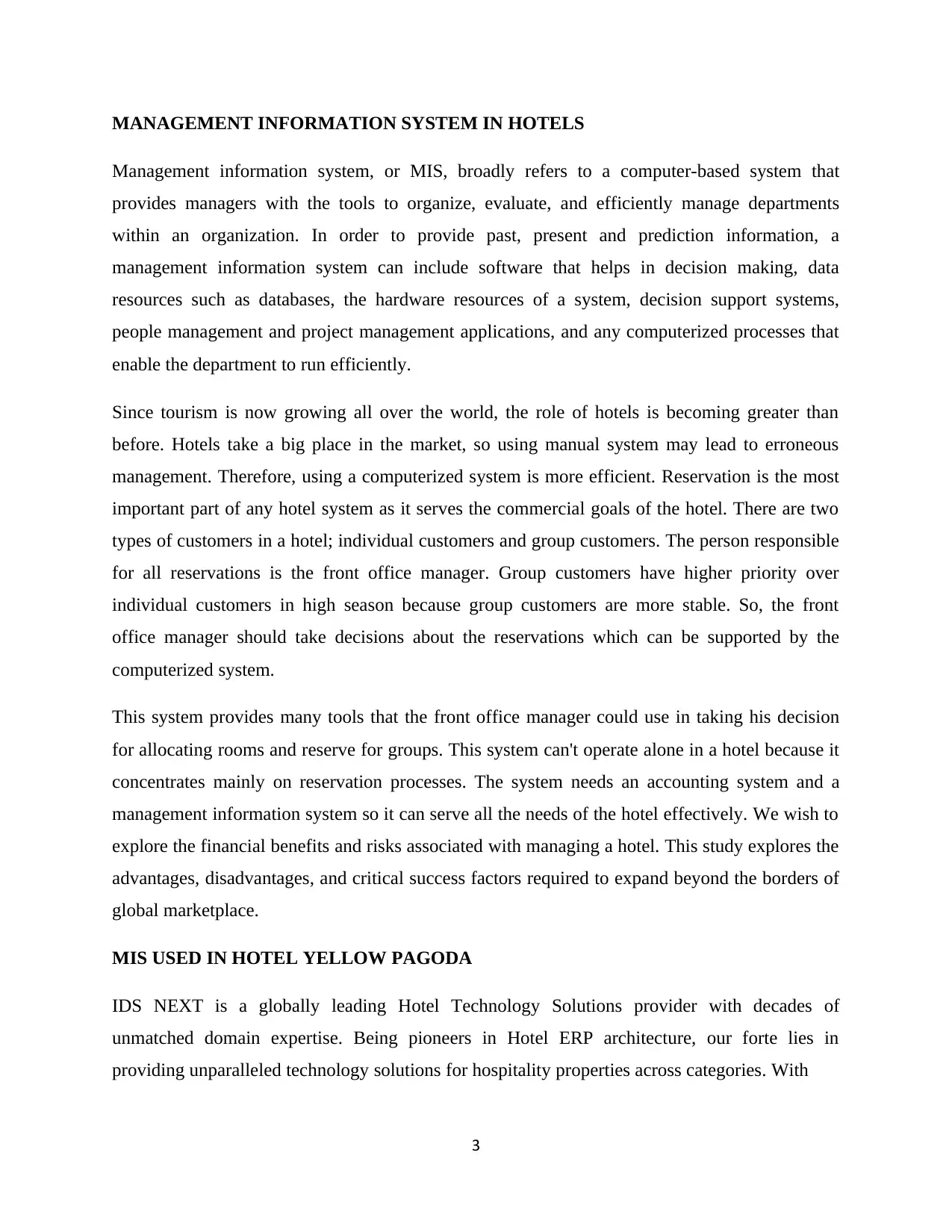
MANAGEMENT INFORMATION SYSTEM IN HOTELS
Management information system, or MIS, broadly refers to a computer-based system that
provides managers with the tools to organize, evaluate, and efficiently manage departments
within an organization. In order to provide past, present and prediction information, a
management information system can include software that helps in decision making, data
resources such as databases, the hardware resources of a system, decision support systems,
people management and project management applications, and any computerized processes that
enable the department to run efficiently.
Since tourism is now growing all over the world, the role of hotels is becoming greater than
before. Hotels take a big place in the market, so using manual system may lead to erroneous
management. Therefore, using a computerized system is more efficient. Reservation is the most
important part of any hotel system as it serves the commercial goals of the hotel. There are two
types of customers in a hotel; individual customers and group customers. The person responsible
for all reservations is the front office manager. Group customers have higher priority over
individual customers in high season because group customers are more stable. So, the front
office manager should take decisions about the reservations which can be supported by the
computerized system.
This system provides many tools that the front office manager could use in taking his decision
for allocating rooms and reserve for groups. This system can't operate alone in a hotel because it
concentrates mainly on reservation processes. The system needs an accounting system and a
management information system so it can serve all the needs of the hotel effectively. We wish to
explore the financial benefits and risks associated with managing a hotel. This study explores the
advantages, disadvantages, and critical success factors required to expand beyond the borders of
global marketplace.
MIS USED IN HOTEL YELLOW PAGODA
IDS NEXT is a globally leading Hotel Technology Solutions provider with decades of
unmatched domain expertise. Being pioneers in Hotel ERP architecture, our forte lies in
providing unparalleled technology solutions for hospitality properties across categories. With
3
Management information system, or MIS, broadly refers to a computer-based system that
provides managers with the tools to organize, evaluate, and efficiently manage departments
within an organization. In order to provide past, present and prediction information, a
management information system can include software that helps in decision making, data
resources such as databases, the hardware resources of a system, decision support systems,
people management and project management applications, and any computerized processes that
enable the department to run efficiently.
Since tourism is now growing all over the world, the role of hotels is becoming greater than
before. Hotels take a big place in the market, so using manual system may lead to erroneous
management. Therefore, using a computerized system is more efficient. Reservation is the most
important part of any hotel system as it serves the commercial goals of the hotel. There are two
types of customers in a hotel; individual customers and group customers. The person responsible
for all reservations is the front office manager. Group customers have higher priority over
individual customers in high season because group customers are more stable. So, the front
office manager should take decisions about the reservations which can be supported by the
computerized system.
This system provides many tools that the front office manager could use in taking his decision
for allocating rooms and reserve for groups. This system can't operate alone in a hotel because it
concentrates mainly on reservation processes. The system needs an accounting system and a
management information system so it can serve all the needs of the hotel effectively. We wish to
explore the financial benefits and risks associated with managing a hotel. This study explores the
advantages, disadvantages, and critical success factors required to expand beyond the borders of
global marketplace.
MIS USED IN HOTEL YELLOW PAGODA
IDS NEXT is a globally leading Hotel Technology Solutions provider with decades of
unmatched domain expertise. Being pioneers in Hotel ERP architecture, our forte lies in
providing unparalleled technology solutions for hospitality properties across categories. With
3
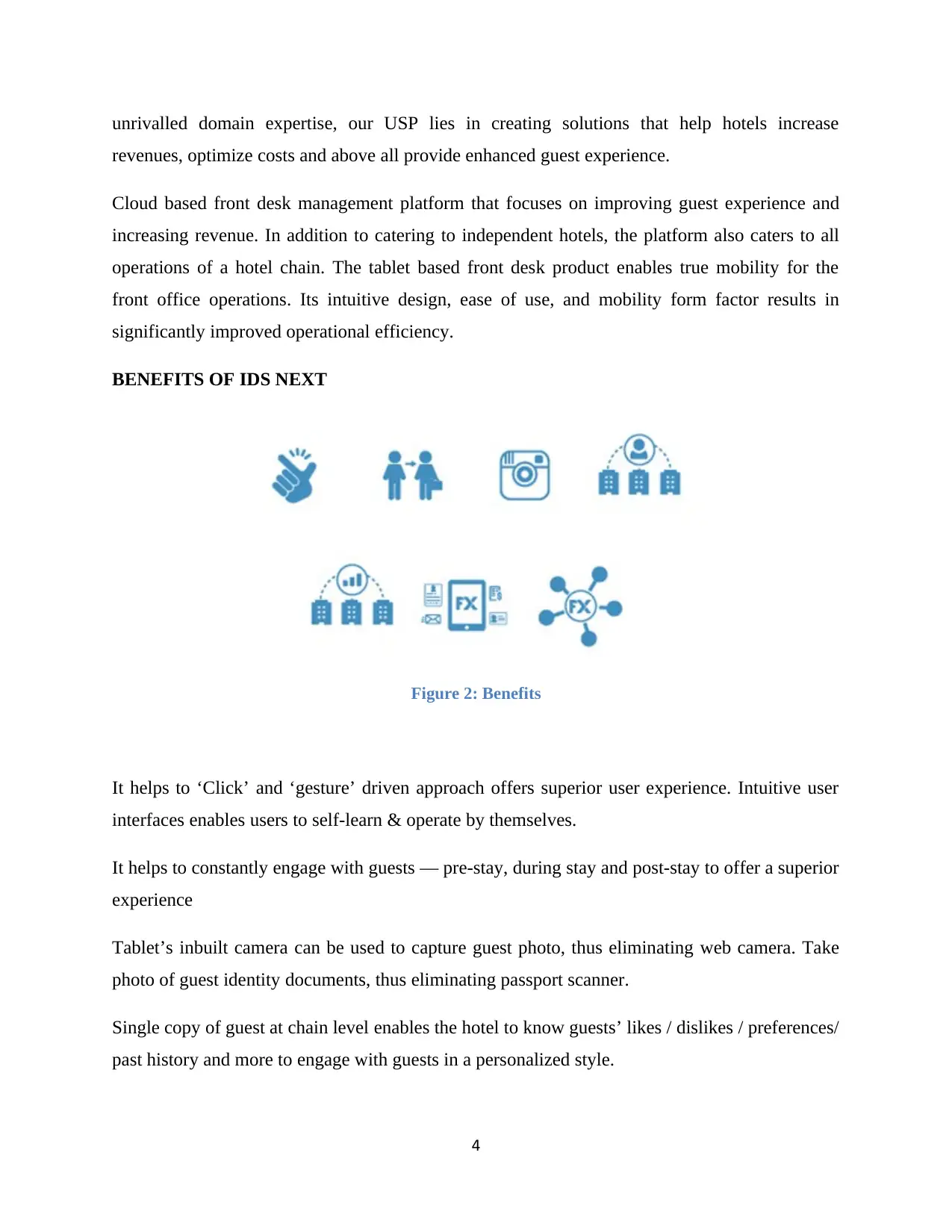
unrivalled domain expertise, our USP lies in creating solutions that help hotels increase
revenues, optimize costs and above all provide enhanced guest experience.
Cloud based front desk management platform that focuses on improving guest experience and
increasing revenue. In addition to catering to independent hotels, the platform also caters to all
operations of a hotel chain. The tablet based front desk product enables true mobility for the
front office operations. Its intuitive design, ease of use, and mobility form factor results in
significantly improved operational efficiency.
BENEFITS OF IDS NEXT
Figure 2: Benefits
It helps to ‘Click’ and ‘gesture’ driven approach offers superior user experience. Intuitive user
interfaces enables users to self-learn & operate by themselves.
It helps to constantly engage with guests — pre-stay, during stay and post-stay to offer a superior
experience
Tablet’s inbuilt camera can be used to capture guest photo, thus eliminating web camera. Take
photo of guest identity documents, thus eliminating passport scanner.
Single copy of guest at chain level enables the hotel to know guests’ likes / dislikes / preferences/
past history and more to engage with guests in a personalized style.
4
revenues, optimize costs and above all provide enhanced guest experience.
Cloud based front desk management platform that focuses on improving guest experience and
increasing revenue. In addition to catering to independent hotels, the platform also caters to all
operations of a hotel chain. The tablet based front desk product enables true mobility for the
front office operations. Its intuitive design, ease of use, and mobility form factor results in
significantly improved operational efficiency.
BENEFITS OF IDS NEXT
Figure 2: Benefits
It helps to ‘Click’ and ‘gesture’ driven approach offers superior user experience. Intuitive user
interfaces enables users to self-learn & operate by themselves.
It helps to constantly engage with guests — pre-stay, during stay and post-stay to offer a superior
experience
Tablet’s inbuilt camera can be used to capture guest photo, thus eliminating web camera. Take
photo of guest identity documents, thus eliminating passport scanner.
Single copy of guest at chain level enables the hotel to know guests’ likes / dislikes / preferences/
past history and more to engage with guests in a personalized style.
4
⊘ This is a preview!⊘
Do you want full access?
Subscribe today to unlock all pages.

Trusted by 1+ million students worldwide
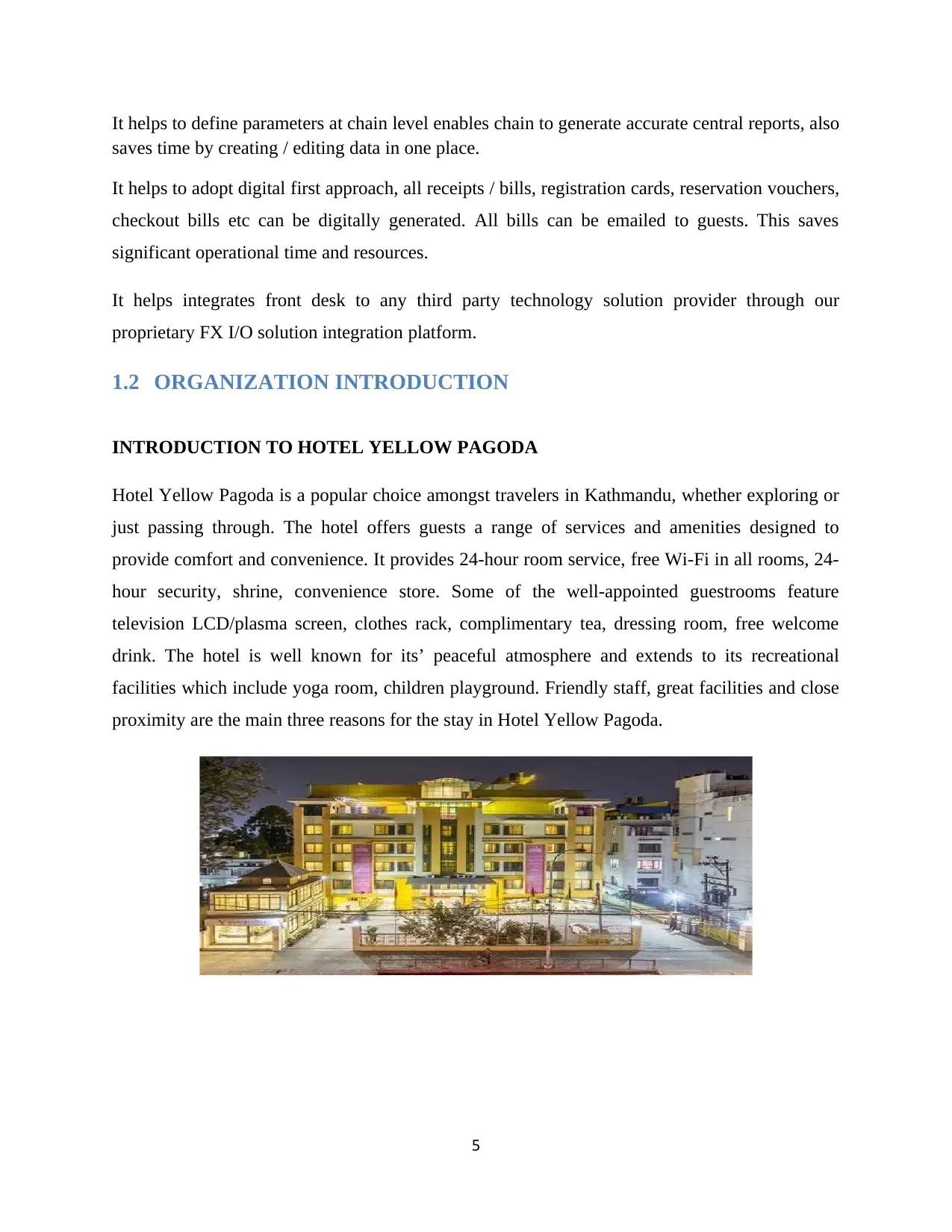
It helps to define parameters at chain level enables chain to generate accurate central reports, also
saves time by creating / editing data in one place.
It helps to adopt digital first approach, all receipts / bills, registration cards, reservation vouchers,
checkout bills etc can be digitally generated. All bills can be emailed to guests. This saves
significant operational time and resources.
It helps integrates front desk to any third party technology solution provider through our
proprietary FX I/O solution integration platform.
1.2 ORGANIZATION INTRODUCTION
INTRODUCTION TO HOTEL YELLOW PAGODA
Hotel Yellow Pagoda is a popular choice amongst travelers in Kathmandu, whether exploring or
just passing through. The hotel offers guests a range of services and amenities designed to
provide comfort and convenience. It provides 24-hour room service, free Wi-Fi in all rooms, 24-
hour security, shrine, convenience store. Some of the well-appointed guestrooms feature
television LCD/plasma screen, clothes rack, complimentary tea, dressing room, free welcome
drink. The hotel is well known for its’ peaceful atmosphere and extends to its recreational
facilities which include yoga room, children playground. Friendly staff, great facilities and close
proximity are the main three reasons for the stay in Hotel Yellow Pagoda.
5
saves time by creating / editing data in one place.
It helps to adopt digital first approach, all receipts / bills, registration cards, reservation vouchers,
checkout bills etc can be digitally generated. All bills can be emailed to guests. This saves
significant operational time and resources.
It helps integrates front desk to any third party technology solution provider through our
proprietary FX I/O solution integration platform.
1.2 ORGANIZATION INTRODUCTION
INTRODUCTION TO HOTEL YELLOW PAGODA
Hotel Yellow Pagoda is a popular choice amongst travelers in Kathmandu, whether exploring or
just passing through. The hotel offers guests a range of services and amenities designed to
provide comfort and convenience. It provides 24-hour room service, free Wi-Fi in all rooms, 24-
hour security, shrine, convenience store. Some of the well-appointed guestrooms feature
television LCD/plasma screen, clothes rack, complimentary tea, dressing room, free welcome
drink. The hotel is well known for its’ peaceful atmosphere and extends to its recreational
facilities which include yoga room, children playground. Friendly staff, great facilities and close
proximity are the main three reasons for the stay in Hotel Yellow Pagoda.
5
Paraphrase This Document
Need a fresh take? Get an instant paraphrase of this document with our AI Paraphraser
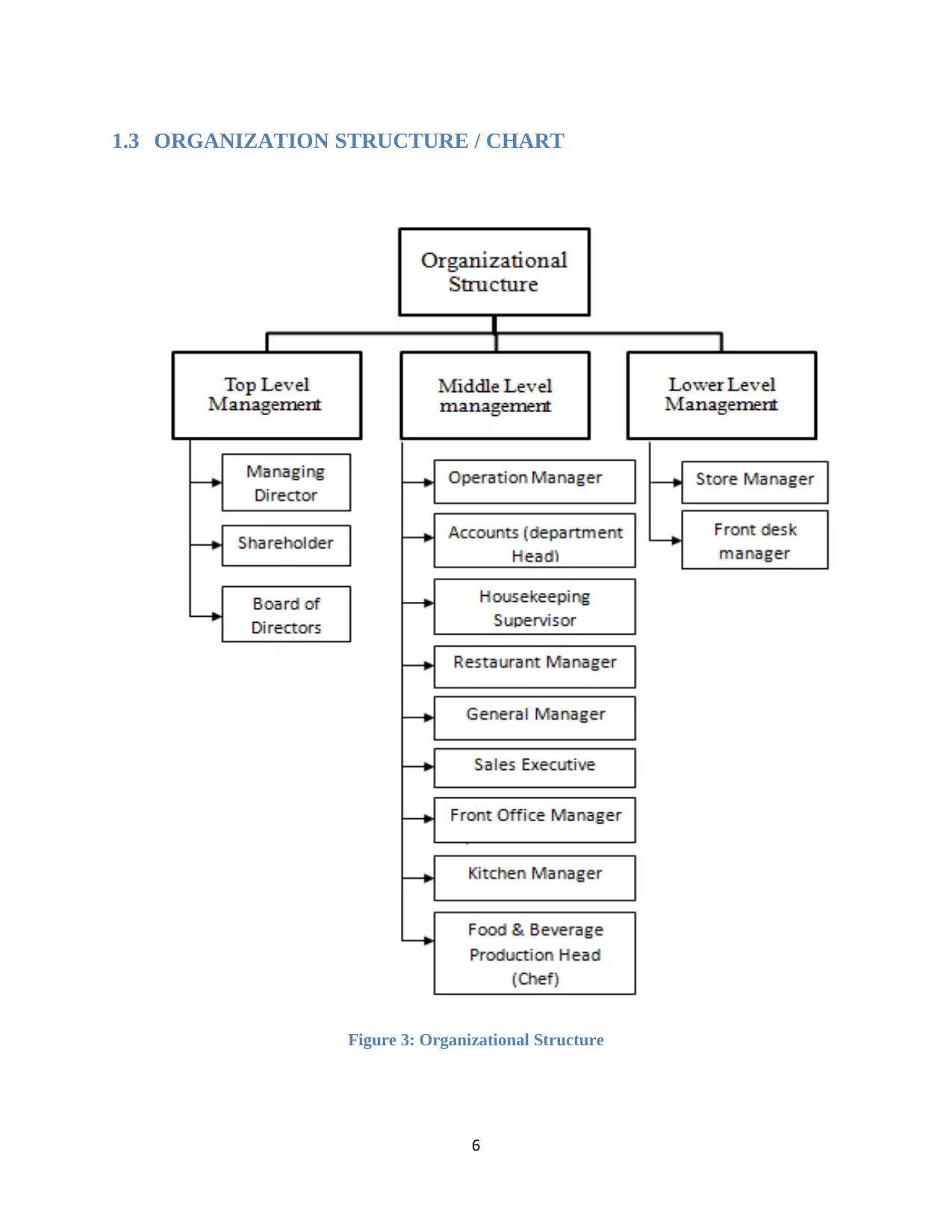
1.3 ORGANIZATION STRUCTURE / CHART
Figure 3: Organizational Structure
6
Figure 3: Organizational Structure
6

7
⊘ This is a preview!⊘
Do you want full access?
Subscribe today to unlock all pages.

Trusted by 1+ million students worldwide
1 out of 17
Related Documents
Your All-in-One AI-Powered Toolkit for Academic Success.
+13062052269
info@desklib.com
Available 24*7 on WhatsApp / Email
![[object Object]](/_next/static/media/star-bottom.7253800d.svg)
Unlock your academic potential
Copyright © 2020–2025 A2Z Services. All Rights Reserved. Developed and managed by ZUCOL.





